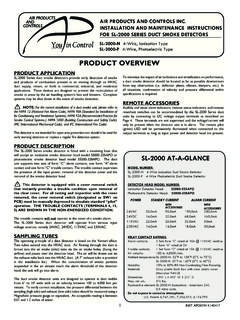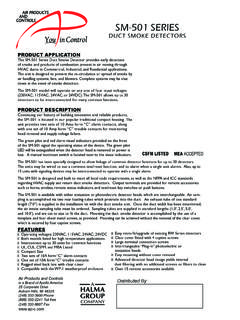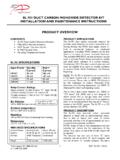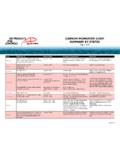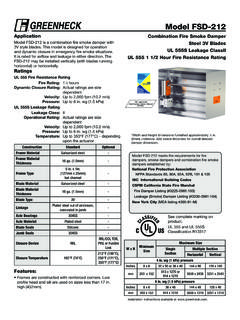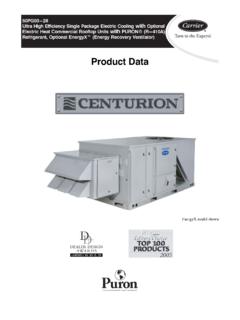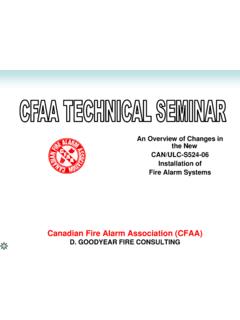Transcription of INST APD0194 I090317 (SL-2000 Series Installation ...
1 INST APD0194 I090317SL- 2000 -N4-Wire, Ionization TypeSL- 2000 -P4-Wire, Photoelectric TypeAIR PRODUCTS AND CONTROLS AND MAINTENANCE INSTRUCTIONSFOR SL- 2000 Series duct smoke DETECTORSPRODUCT OVERVIEWPRODUCT APPLICATIONSL- 2000 Series duct smoke detectors provide early detection ofsmoke and products of combustion present in air moving through anHVAC duct supply, return, or both in commercial, industrial, andresidential applications. These devices are designed to prevent therecirculation of smoke in areas by the air handling system s fans andblowers. Complete systems may be shut down in the event ofsmoke detection.*NOTE:For the correct Installation of a duct smoke unit, pleaserefer to the NFPA 72 (National Fire Alarm Code), NFPA 90A(Standard for Installation of Air Conditioning and VentilationSystems),NFPA 92A (Recommended Practice for smoke ControlSystems.)
2 , NFPA 5000 (Building Construction and Safety Code),IMC (International Mechanical Code), and IFC (International FireCode).This detector is not intended for open area protection nor should it be usedfor early warning detection or replace a regular fire detection DESCRIPTIONThe SL- 2000 Series smoke detector is fitted with a mounting basethat will accept an ionization smoke detector head model 55000-225 APO or photoelectric smoke detector head model 55000-328 APO. The duct unit supports two sets of form C alarm contacts,one form A alarm contact and one form C trouble contact. Thetrouble contact supervises the presence of the input power, removalof the detector cover and the removal of the smoke detector head. *This detector is equipped with a cover removal switchthat instantly provides a trouble condition upon removal ofthe clear cover.
3 For all testing and inspection with the coverremoved, the cover removal switch (designated as SW1 onPCB) must be manually depressed to simulate standard pilot operation. THE TROUBLE CONTACTS (TERMINALS4,15, 5) ARE SHOWN IN THE NON-ENERGIZED trouble contacts will notoperate in the event of a smoke SL- 2000 Series duct detector will operate from various inputvoltage sources; namely 24 VAC, 24 VDC, 115 VAC and TUBESThe operating principle of a duct detector is based on the Venturieffect. Two tubes extend into the HVAC duct . Air flowing through theduct is forced into the air intake (inlet) tube via the air intake holes,(facing the airflow) and passes over the detector head. The air willbe drawn out via the exhaust tube back into the HVAC duct . (A 7 exhaust tube is provided in the Installation kit.)
4 When theconcentration of smoke particles suspended in the air stream reachthe alarm threshold of the detector head, the unit will go into duct smoke detector units are designed to operate in duct widthsfrom 6 to 10 wide with an air velocity between 100 to 4,000 feet perminute. To verify correct Installation , the pressure differentialbetween the sampling (high side) and exhaust (low side) tubesshould be measured using a Magnehelic pressure gauge orequivalent. An acceptable reading is between and inchesof minimize the impact of air turbulence and stratification onperformance, a duct smoke detector should be located as far aspossible downstream from any obstruction ( deflector plates,elbows, dampers, etc.). In all situations, confirmation of velocity andpressure differential within specifications is required.
5 REMOTE ACCESSORIESA udible and visual alarm indicators, remote status indicators, andremote reset/test switches can be accommodated by the SL- 2000 Series duct units by connecting to DC voltage output terminals asdescribed on Page 4. These terminals are not supervised and thevoltage/current will only be present when the detector unit is inalarm. The remote pilot (green) LED will be permanentlyilluminated when connected to the output terminals as long as inputpower and detector head are present. SL- 2000 AT-A-GLANCEMODEL NUMBER:SL- 2000 -N 4-Wire Ionization duct smoke Detector SL- 2000 -P 4-Wire Photoelectric duct smoke DetectorDETECTOR HEAD MODEL NUMBER:Ionization Detector Head: 55000-225 APOP hotoelectric Detector Head:55000-328 APORELAY CONTACT RATINGS:Alarm contacts:2 Sets form C rated at 10A @ 115 VAC resistive1 form A rated at 2 ATrouble contacts:1 Set form C rated at 10A @ 115 VAC resistive Air velocity:100 to 4,000 temperature:SL- 2000 -N: 32 F to 158 F (0 C to 70 C)SL- 2000 -P: 32 F to 140 F (0 C to 60 C)Humidity: 10% to 85% RH Non-Condensing/Non-FreezingMaterial:Gray plastic back box with clear plastic cover (Makrolon 94V-0)Dimensions:13 L X 4 W X 2 DMax.
6 Net wt.:3 element:SL- 2000 -N (Ionization) - Americium 241, micro not expose to corrosive Patents 6,741,181; 7,204,522; 1 POWERSTANDBY CURRENTALARM APD0194 I090317 LOCATION PREREQUISITESThis guideline contains general information on duct smokedetector Installation , but does not preclude the NFPA and/or ICCdocuments listed. Air Products and Controls assumes noresponsibility for improperly installed duct detectors . To determinethe correct Installation position for an SL- 2000 Series duct smokedetector, the following factors must be ) A uniform non-turbulent (laminar) airflow between 100 4,000 ft/min. must be present in the HVAC duct . To determineduct velocities, examine the engineering specifications thatdefine the expected velocities or use an Alnor model 6000 APvelocity meter (or equivalent).
7 2) To minimize the impact of air turbulence and stratificationon performance, a duct smoke detector should be located asfar as possible downstream from any obstruction ( deflectorplates, elbows, dampers, etc.). In all situations, confirmation ofvelocity and pressure differential within specifications pressure differential between the input sampling (highpressure) tube and exhaust (low pressure) tube for the SL- 2000 Series smoke duct detector should be greater inches of water and less than inches of ) Identify a code compliant location (supply or return side, or both) for the Installation of the duct unit that will permit easy access for viewing and ) When installing on the return side, install duct units prior tothe air being exhausted from the building or diluted with outside fresh )
8 When installing duct smoke units downstream of filters,fires occurring in the filters will be detected, but if the filtersbecome blocked, insufficient air flow through the duct unit willprevent the correct operation of the duct detector. duct unitsinstalled in the supply air side may monitor upstreamequipment and/or ) Where possible, install duct detectors upstream of airhumidifiers and downstream of ) To prevent false alarms, the duct detector should not bemounted in areas of extreme high or low temperatures, inareas where high humidity exists, or in areas where the ductmay contain gases or excessive TUBE ASSEMBLYThe SL- 2000 Series duct smoke detectors employ a speciallynotched sampling tube, which must be ordered separately in oneof four standard duct widths of 6 TO duct widths of TO duct widths of TO duct widths of TO Standard sampling tubes are steel tubes with air intake holesdrilled the entire length of the tube.
9 These tubes can be cut tolength and must span at least 80% the width of the duct . Samplingtubes over must be supported on the opposite side of the ensure the correct operation of the sensing tube, the red endcap (red stopper in Installation kit) must be inserted in the end of the air intake sampling tube. For custom duct widths, always use the next longest standard size and cut down to theexact requirement. MECHANICAL Installation NO-TOOLS TUBE INSTALLATIONThe SL- 2000 Series duct smoke detector provides a unique,patented mechanism for Installation and/or removal of thesampling and exhaust tubes from either the front or rear of thedetector the airflow direction has been determined, insert the inletand exhaust tubes into the duct smoke detector.
10 If the cover isin place, the tubes may be inserted into the back of the detectorvia the key-slots provided. Simply push the tube into placeagainst the spring loaded retainer, and turn into the correctposition, allowing the key to lock the tube in the desiredorientation. For front side Installation , simply rotate the tuberetainer until the tube may be inserted and oriented the tube is installed, rotate the retainer back into place tolock down the tube. Ensure air intake sampling tube is positionedso that the inlet holes are directly facing the PREPARATIONR emove mounting template from the Installation kit. Removepaper backing from the mounting template and affix it to the ductat the desired location. Using the template as a guide, drill (2)mounting holes, 3/32 ( ) for the #12 X sheet metalscrews packaged in the Installation kit.
